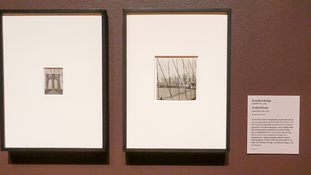What do you want to get out of large format? What are your expectations? If you are looking for the ability to make bigger enlargements, smoother tonality, the ability to control exposure and processing on an image-by-image basis, and the ability to control the image in-camera, then large format is a good option. There are lots of options people have discussed here already - the basic camera types are press cameras, field cameras, and view cameras.
Almost all large format cameras (with a few highly specialized exceptions) have interchangeable lenses. One nice feature is that you are not limited by brand or vintage in which lenses you can use. I can use a lens from the 1850s on my ca. 2010 camera, and a 1950s lens on my ca. 1880 camera.
A press camera has very limited movements, and the primary benefit to a press camera is the big negative. Some press cameras, most notably the Speed Graphic, have a focal plane shutter that will let you use a very wide range of lenses including antique lenses that lack an internal shutter. Press cameras also have limited bellows extension, as they were optimized for a mild-wide-angle (127-135mm) lens (the equivalent of a 35-40mm lens on 35mm). They are also limited at the wide end, with a 90mm being about the widest you can use (28mm equivalent) practically. They9 are self-casing, with the bed and focusing rails forming the door to the body of the camera, so they can be carried around and used in almost any circumstances. Most have a fixed back in the horizontal orientation, so if you want to shoot portraits with it, you'll have to turn the camera sideways, but there are some like the Busch Pressman that do have a revolving back. Because of these limitations, press cameras are generally inexpensive.
A field camera has more movements and much greater flexibility in bellows, allowing for use of a wider range of lenses. Field cameras are also, for the most part, self-casing so they can be transported easily. This is the camera type most people think of when they think of large format - Ansel Adams on the roof of his estate wagon, photographing in Yosemite National Park. Field cameras run the range of price from inexpensive (maybe $300 or so) on up to multiple thousands of pounds, depending on the features you want and how light weight you want it to be. Field cameras come in an impressive array of sizes and formats - I have field cameras in my arsenal ranging from 4x5 up to 14x17, with stops along the way at 5x7, 5x12, 6.5x8.5, 8x10, and 11x14.
A view camera (also often referred to as a monorail) has a rail (very rarely two rails) on which front and rear standards that hold the lens, bellows, and ground glass/film stage are mounted. Monorails also come in a bewildering array of sizes, configurations and options. The big benefits to monorail cameras are the nearly unlimited amount of movements you can apply, and the theoretically unlimited extension of the bellows that is possible (this allows you to use very long telephoto lenses or do extreme macro work (closer than 1:1). Most monorails come with a base rail and allow for extensions, but some inexpensive ones (like the old Kodak/Calumet/Orbit monorail camera) have a fixed length rail somewhere in the 18-24" range. While this allows for a fair bit of flexibility in choosing lenses and focusing close, the downside is that they are not very compact or portable. If you think you want a monorail camera, but also want to use it in the field, I would highly recommend looking at a Sinar F/F+/F1/F2 (different generations of the same camera). Sinar makes a minimum 6" base rail you can slide the front and rear standards on to for transport, and then easily add and remove a 12" extension rail when you are at your location (the F in the model name stands for Field, as opposed to their P series, which are very precise, professional instruments - thus the P).
I realize this is a tremendous amount of information to sift through, but I hope it helps you come to a better understanding of the various camera types and what particular applications they fit. This is not a complete comprehensive guide to all large format camera types (for example there are large format SLRs, but that's yet another kettle of fish). Please ask specific questions and we'll try to help out as best we can (the we here is the members of the forum, not me using the royal we).








